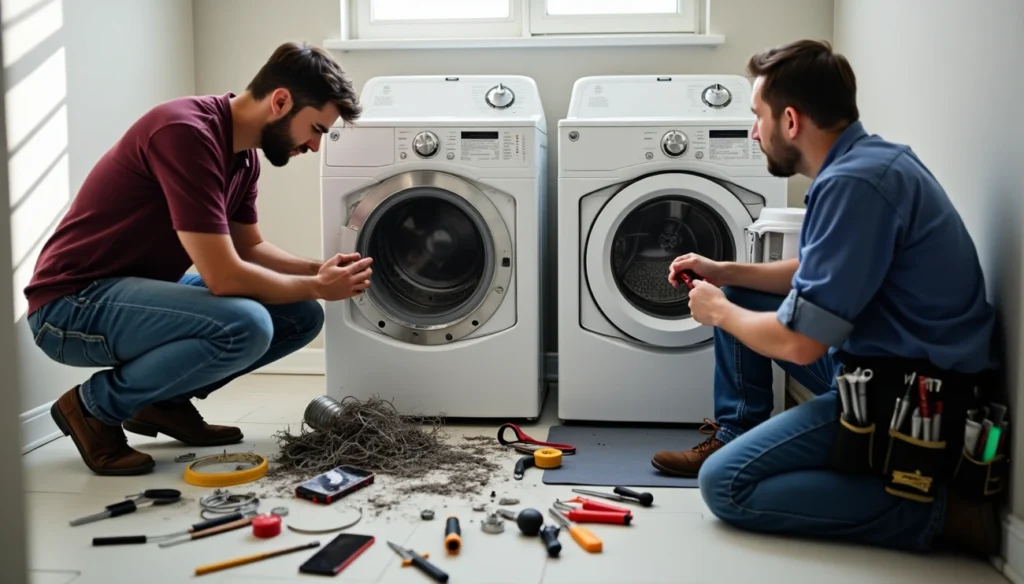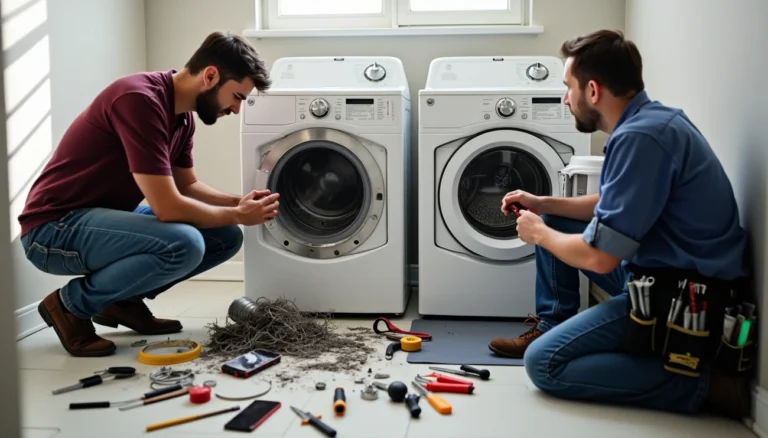
Written by ANH Appliacne Repair
Published on: May 1, 2025
Reading time: 1 minute
Why Your Dryer Repair Could Cost You Double (Unless You Read This First)
Is your dryer broken? Not sure if you need a professional repair? You’re not alone. Noisy dryers make up 35% of all reported problems, and dryers that won’t start affect another 22% of customers. These common issues impact millions of homeowners every year.
Jumping into repairs without proper knowledge could cost you twice as much as needed. The market offers over 4 million parts from more than 150 major brands for dryer repairs. Picking the wrong part leads to expensive mistakes. Many homeowners search for “dryer repairs near me” or “laundry dryer repair” services without knowing the key factors that affect the final cost. On top of that, local repair technicians don’t always carry genuine manufacturer parts needed for quality fixes. Your average dryer should last about 14 years, so learning the true cost of repairs in your area before making a decision can save you money.
This piece will guide you through common dryer problems, DIY repair risks, and smart strategies to avoid overpaying for repairs. Your machine might not heat, tumble, or start – these tips will help you make better choices before spending your money.
The most common dryer issues that lead to costly repairs
At the time your dryer stops working, knowing the most common problems can help you avoid repairs that get pricey. Let’s get into the typical issues that make homeowners frantically search for “dryer repairs near me.”
Dryer won’t start: overlooked fuse or switch
The first step is to check your dryer’s power supply. A blown thermal fuse usually stops your dryer from turning on. This safety feature protects components from high voltage damage. The door switch needs inspection next. Your dryer won’t work if it doesn’t detect a closed door. You should hear a click as the door closes. A switch replacement might be needed if this sound is missing.
No heat: heating element vs. thermostat confusion
A dryer that runs without heat can be really frustrating. Electric dryers often have a blown thermal fuse that lets the drum tumble but prevents heating. A broken heating element means no heat at all. Many homeowners mix up thermostat issues with heating element failures and buy incorrect parts. The cycling thermostat manages the drum’s temperature, while the heating element produces heat.
Drum not spinning: belt or motor failure
The drive belt has definitely broken if you hear the motor but see a still drum. This belt connects the drum, motor pulley, and tension pulley. The drum’s support wheels, called rollers, can wear out. This prevents proper spinning and creates squealing sounds. A humming noise during startup usually points to motor problems.
Dryer overheating: clogged vents or faulty sensors
Restricted airflow leads to dangerous overheating. Hot air gets trapped when lint filters or exhaust vents are blocked. The trapped heat builds up in the drum and could start a fire. A bad cycling thermostat might fail to shut off the heating element, which lets temperatures rise too high. Burn marks on clothes show that the temperature control isn’t working right.
Local repair services often tell us that basic maintenance could prevent these problems that get pricey.
Why DIY dryer repair can backfire (and cost you double)
You might want to fix your dryer yourself since professional service calls cost between $75-$150 before parts. In spite of that, trying to repair it yourself often doubles your expenses and adds frustration. Here’s why many homeowners wish they hadn’t tried DIY repairs.
Misdiagnosing the problem
Modern dryers have complex electrical systems that make accurate diagnosis hard without proper training. Repair experts say wrong diagnosis tops the list of DIY mistakes. To cite an instance, people often replace expensive heating elements when the real issue lies in the sensor or timer connected to it. Professional repair technicians use specialized diagnostic tools to find the exact problem, which helps avoid buying unnecessary parts and repeated repair attempts.
Using the wrong replacement parts
Cheap aftermarket parts instead of manufacturer-recommended components often break down too soon. A homeowner’s story shows how a $25 aftermarket heating element melted within two months, while the proper OEM part would have cost $75. Your warranty becomes void with unauthorized parts, leaving you to pay full replacement costs if something breaks. The failure rate of some aftermarket components reaches 1 in 50, while genuine parts rarely fail.
Skipping safety checks
Dryers use over 30 amps of electricity, which creates major shock risks. Gas dryers bring extra dangers if connections leak, which could cause explosions or carbon monoxide poisoning. Professional technicians follow strict safety protocols and testing procedures that DIY repairs usually miss. They also know building codes and warranty requirements that amateur repairs typically violate.
Damaging other components during repair
Inexperienced hands often cause extra damage during repairs. Dryers have delicate mechanical parts that need careful handling, and wrong moves can break more components. DIY repairs sometimes involve makeshift fixes or wrong tools that hurt the appliance’s performance. Failed DIY attempts waste money on parts plus the cost of professional repairs that you’ll need anyway.
The next time you search for “dryer repairs near me,” note that professional repair services save you money over time.
Hidden costs most people miss when repairing a dryer
Your dryer repair bill could easily double due to hidden expenses that go beyond basic parts and labor costs. Many homeowners get surprised by these unexpected charges, even after they find “dryer repairs near me.”
Repeat service calls
Homeowners often pay for multiple diagnostic visits because their original repair doesn’t fix the problem. The diagnostic fees usually cost between $50-$150 per visit. Some companies waive this fee when you choose their service, but you’ll need to pay again if the problem comes back after repairs. The situation becomes especially frustrating when you have after-hours or weekend service calls that charge premium rates. My experience shows many cases where wrong diagnosis resulted in three or four service visits—each requiring its own fee.
Shipping delays for parts
Shipping complications with replacement parts ordered online add substantial costs and frustration. Parts typically take 2-5 business days with standard ground shipping, but carrier problems and weather can extend this time substantially. Shipping to Alaska and Hawaii costs a flat rate of $24.99, and some specialized parts face backorder delays from August through December. These delays mean more time without a working dryer, which could add laundromat expenses to your repair costs.
Incorrect part returns
Returning wrong parts leads to unexpected penalties. Vendors require a Return Materials Authorization (RMA) number to process any return. Full credit might apply to parts returned within 30 days, but items returned between 31-90 days usually cost a $15 restocking fee. Parts become non-returnable after 90 days. Electronic components can’t be returned once installed, and you’ll need to cover the return shipping costs—not the vendor.
Tool purchases you’ll only use once
Dryer repairs need specialized tools that might never see use again. Professional repair technicians already own these tools, but DIYers must buy items like specialty screwdrivers and putty knives. Complete repair kits cost $50-$100 and only fix specific issues like noisy dryers. These expensive tools end up collecting dust after a single use.
How to avoid overpaying for dryer repair
Smart preparation helps you avoid inflated dryer repair bills. Many homeowners save hundreds of dollars by taking a few simple steps before making that service call.
Use model-specific troubleshooting guides
Your dryer’s exact model number matters before any diagnosis begins. Repair experts say writing down symptoms before calling can cut labor charges and speed up repairs. Manufacturer’s troubleshooting guides are a great way to get solutions without professional help. Consumer Reports shows that 69% of members tried to repair their dryers themselves during breakdowns, and many fixed simple issues successfully.
Watch brand-specific disassembly videos
Online resources have reshaped the scene of appliance repairs. Platforms like RepairClinic.com, AppliancePartsPros.com, and PartSelect.com show step-by-step videos for almost every dryer model. YouTube has many brand-specific tutorials that show how to take apart dryers from manufacturers like Samsung. These resources help you decide if you need professional help or can handle an easy fix.
Compare local service rates for dryer repairs near me
Location and dryer type affect repair costs. Lower-priced gas dryers (under $800) cost about $149 to fix, while higher-priced models run around $192. Budget electric dryer repairs cost $133, and premium units reach $215. Service charges usually run between $120-$170, but can hit $275 in large cities and coastal areas. Getting at least three quotes from different dryer repairers saves you money.
Ask about warranties before booking a repair
Check if your dryer’s manufacturer warranty still applies before scheduling service. Consumer Reports members paid for 60% of repairs out-of-pocket, but original warranties covered at least part of the costs for 27% of them. Extended warranties can lower repair costs for eligible issues. Your appliance’s repair and maintenance records help technicians diagnose problems faster and track warranty coverage.
Conclusion
Making the Right Call on Your Dryer Repair
Common dryer problems like heating element failures, broken belts, and faulty thermostats can become expensive nightmares if you don’t handle them properly. Without doubt, good preparation and knowledge make the difference between a reasonable repair and a financial disaster.
DIY repairs look tempting at first. But misdiagnosis, wrong parts, and safety risks often double your costs. Hidden expenses like repeat service calls and shipping delays can turn a simple fix into a budget-breaking ordeal.
Your best defense against repair overcharging is knowledge. Before you call any service provider, write down your model number and list all symptoms. Getting multiple quotes from local technicians can save you hundreds of dollars. Repair costs vary a lot between areas and dryer types.
Don’t forget to check your warranty coverage. Many homeowners miss this money-saving opportunity, yet proper documentation could get you free or substantially discounted repairs.
Good preparation can turn a $400 repair nightmare into a $150 solution. Dryer problems are frustrating, but these strategies will help you handle repairs with confidence and protect your budget. Your wallet will thank you.
FAQs
Q1. How much does a typical dryer repair cost? The average cost for dryer repairs is around $180, but can range from $100 to $430 depending on the specific issue, brand, and model of the dryer. Labor costs and parts pricing contribute significantly to the total repair expense.
Q2. What are some common dryer problems that lead to repairs? Common dryer issues include failure to start, lack of heat, drum not spinning, and overheating. These problems can often be traced to faulty components like thermal fuses, heating elements, drive belts, or clogged vents.
Q3. Is it better to repair an old dryer or buy a new one? The decision depends on the age and condition of your dryer. If the repair cost is more than 50% of the price of a new dryer, or if your current dryer is over 10-12 years old, it may be more cost-effective to replace it. However, for newer models or minor issues, repairs can be a good option.
Q4. Can I repair my dryer myself to save money? Many dryer repairs can be done by homeowners with basic tools and some guidance from online tutorials. However, it’s important to prioritize safety and know your limits. Complex issues or those involving gas connections should be left to professionals.
Q5. How can I avoid overpaying for dryer repairs? To avoid overpaying, get multiple quotes from reputable repair services, research common issues for your dryer model, and consider DIY for simple repairs. Always ask about warranty coverage and compare the repair cost to the price of a new dryer before making a decision.



